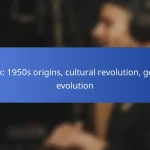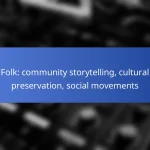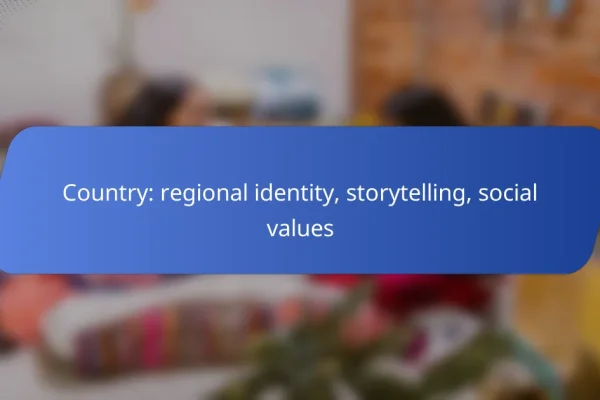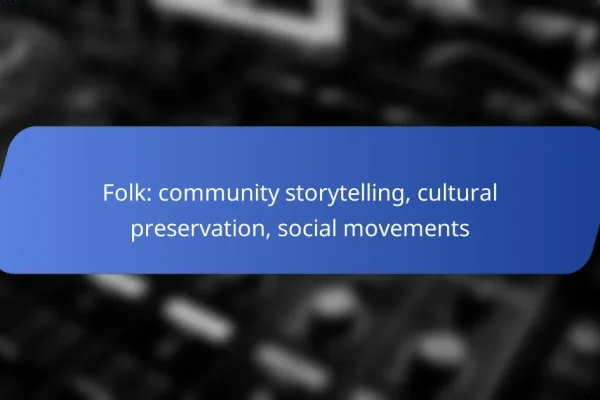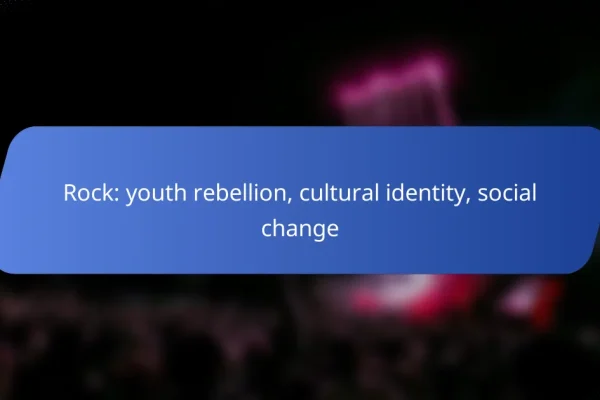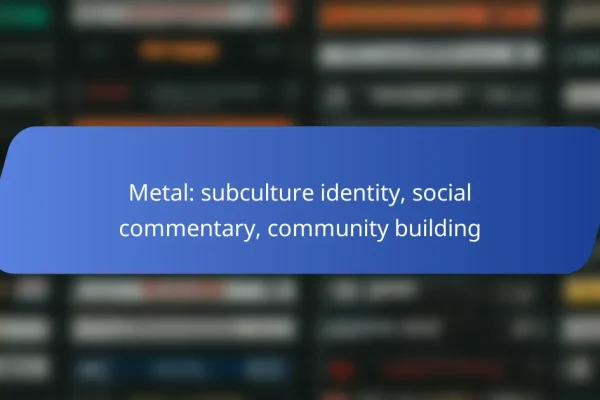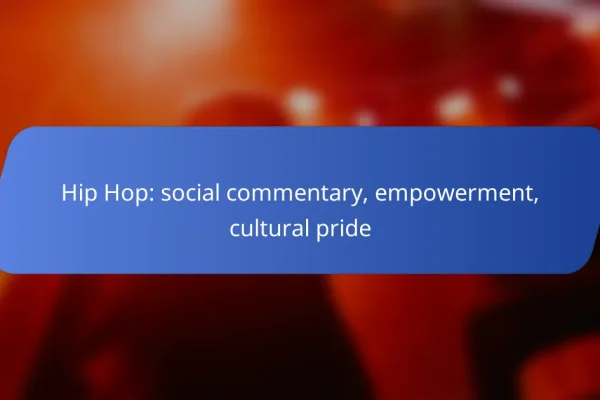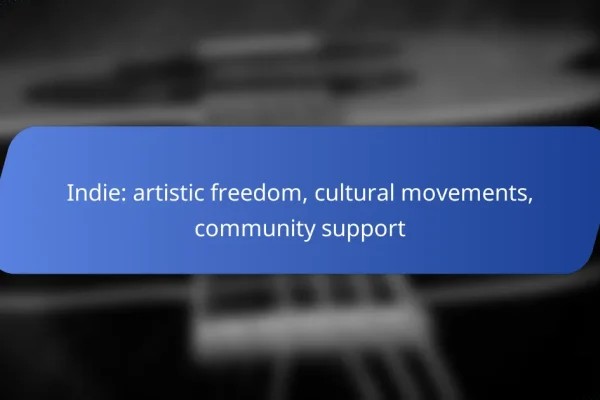How do music genres influence Australian culture?
Music genres significantly shape Australian culture by reflecting societal values, identity, and community connections. Genres like rock, hip hop, and country music resonate with various demographics, influencing lifestyle choices and social movements.
Impact of rock music on youth identity
Rock music has been a powerful force in shaping youth identity in Australia since the 1960s. It often embodies themes of rebellion, freedom, and self-expression, resonating with young Australians seeking to define themselves outside traditional norms.
Local bands like AC/DC and Midnight Oil have not only influenced musical tastes but also fostered a sense of belonging among youth. Rock festivals and concerts serve as communal spaces where young people can connect, share experiences, and express their individuality.
Hip hop’s role in social movements
Hip hop has emerged as a vital platform for social commentary and activism in Australia, particularly among marginalized communities. It addresses issues such as racial inequality, economic disparity, and cultural identity, empowering artists to voice their experiences and advocate for change.
Events like the annual “Hip Hop Weekender” showcase local talent and highlight social issues, creating awareness and fostering dialogue. This genre encourages young Australians to engage in social movements, using music as a tool for advocacy and unity.
Country music’s reflection of rural life
Country music in Australia reflects the experiences and values of rural communities, often celebrating themes of family, hard work, and connection to the land. Artists like Kasey Chambers and Lee Kernaghan capture the essence of rural life, resonating with audiences who share similar backgrounds.
This genre not only entertains but also preserves cultural narratives and traditions, providing a sense of identity for those living in regional areas. Country music festivals, such as the Tamworth Country Music Festival, serve as important cultural events that strengthen community ties and celebrate local heritage.
What are the most popular music genres in Australia?
The most popular music genres in Australia include pop, rock, hip-hop, and electronic dance music (EDM). These genres dominate the charts and reflect the diverse musical tastes of the Australian audience.
Pop music trends in Australian charts
Pop music consistently ranks among the top genres in Australia, with artists like Sia, Tones and I, and The Kid LAROI achieving significant chart success. The Australian pop scene often blends local influences with global trends, resulting in a unique sound that resonates with both domestic and international audiences.
Streaming platforms have played a crucial role in shaping pop music trends, allowing listeners to discover new artists and songs easily. Chart performance is often influenced by social media trends, where viral moments can propel songs to the top of the charts quickly.
Emergence of indie music scenes
Indie music has gained traction in Australia, with vibrant scenes emerging in cities like Melbourne and Sydney. Local festivals and small venues provide platforms for independent artists, fostering a sense of community and collaboration among musicians.
Many indie artists are leveraging digital platforms to distribute their music, often bypassing traditional record labels. This shift allows for greater creative freedom and the ability to connect directly with fans, which is essential for building a loyal following.
Growth of electronic dance music festivals
Electronic dance music (EDM) festivals have surged in popularity across Australia, attracting both local and international talent. Events like Tomorrowland Unite and Stereosonic draw large crowds, showcasing a variety of EDM sub-genres and creating a vibrant festival culture.
The growth of these festivals has also contributed to the local economy, with significant spending on tickets, accommodations, and related services. As the EDM scene continues to evolve, it remains a key player in shaping Australia’s music landscape.
How do music genres shape social interactions?
Music genres significantly influence social interactions by creating shared experiences and fostering connections among individuals. Different genres often attract distinct audiences, leading to the formation of communities that bond over similar tastes and cultural values.
Music festivals as community events
Music festivals serve as vital community events that bring together diverse groups of people who share a passion for specific genres. These gatherings often promote a sense of belonging and unity, as attendees engage in collective experiences, such as dancing, singing, and celebrating their favorite artists.
For example, festivals like Coachella in the United States or Glastonbury in the UK attract thousands, showcasing various genres and encouraging interactions among attendees. Such events can also boost local economies, as they typically involve food vendors, merchandise sales, and accommodations for visitors.
Role of genre in forming social groups
The genre of music plays a crucial role in forming social groups, as individuals often seek out others who share their musical preferences. This can lead to the establishment of fan clubs, online communities, and local meet-ups centered around specific genres, such as hip-hop, rock, or electronic music.
For instance, punk rock enthusiasts may gather at local shows or participate in online forums to discuss bands and share music. These interactions not only strengthen friendships but also create networks that can influence cultural movements and social change.
What are the historical roots of Australian music genres?
The historical roots of Australian music genres are deeply intertwined with the diverse cultures that have shaped the country. From Indigenous traditions to influences brought by British colonization, these elements have created a rich tapestry of musical expression.
Indigenous music traditions
Indigenous music traditions in Australia are among the oldest continuous musical practices in the world. These traditions often feature instruments like the didgeridoo and clapsticks, and they play a crucial role in storytelling and cultural ceremonies.
Music is used to convey spiritual beliefs, connect with the land, and pass down knowledge through generations. The rhythms and melodies reflect the unique landscapes and experiences of Indigenous peoples, making them a vital aspect of Australia’s cultural heritage.
Influence of British colonization on music
The arrival of British colonizers in the late 18th century significantly impacted Australian music. New genres, such as folk and classical music, were introduced, blending with Indigenous sounds to create unique styles. This fusion laid the groundwork for contemporary Australian music.
Colonial influences also led to the development of bush ballads and sea shanties, which reflected the lives and struggles of settlers. Over time, these musical forms evolved, incorporating elements from various immigrant communities, further enriching Australia’s musical landscape.
How do music genres affect mental health?
Music genres can significantly influence mental health by shaping emotions and providing therapeutic benefits. Different styles of music can evoke various feelings, helping individuals cope with stress, anxiety, and depression.
Therapeutic benefits of classical music
Classical music is often associated with relaxation and stress relief. Studies suggest that listening to classical compositions can lower heart rates and reduce anxiety levels, making it a popular choice for therapeutic settings.
Many therapists incorporate classical music into treatment plans, as it can enhance focus and promote a calm environment. For example, playing classical pieces during meditation or yoga sessions can deepen relaxation and improve overall mental well-being.
Impact of upbeat genres on mood
Upbeat music genres, such as pop and dance, can elevate mood and increase energy levels. Listening to lively tracks often leads to the release of dopamine, a neurotransmitter associated with pleasure and reward.
Engaging with upbeat music can be particularly beneficial during physical activities, as it motivates movement and enhances enjoyment. For instance, creating a playlist of energetic songs for workouts can help maintain enthusiasm and improve exercise performance.
What are the future trends in music genres?
Future trends in music genres are increasingly characterized by the rise of genre-blending and the influence of technology, particularly streaming services. As artists experiment with different styles and platforms, the traditional boundaries between genres are becoming less defined.
Rise of genre-blending artists
Genre-blending artists are reshaping the music landscape by combining elements from multiple genres, creating unique sounds that appeal to diverse audiences. For example, artists like Lil Nas X merge country and hip-hop, while Billie Eilish incorporates pop with electronic and indie influences.
This trend encourages creativity and innovation, allowing musicians to reach broader demographics. As a result, listeners are more open to exploring new sounds, leading to a richer musical experience.
Impact of streaming services on genre popularity
Streaming services like Spotify and Apple Music have significantly altered how music genres gain popularity. These platforms use algorithms to recommend songs based on user preferences, often promoting genre-blending tracks that might not fit neatly into traditional categories.
As a result, niche genres can find larger audiences, while mainstream genres may experience fluctuations in popularity. Artists can leverage these platforms to reach global listeners, making it essential to understand how to optimize their presence on streaming services for maximum exposure.
How do music genres reflect cultural diversity?
Music genres serve as a mirror of cultural diversity by embodying the unique traditions, values, and experiences of different communities. Each genre often reflects the historical and social contexts from which it originated, showcasing the rich tapestry of human expression.
Historical Context of Music Genres
The historical context of music genres is crucial in understanding their cultural significance. For instance, blues music emerged from African American communities in the Deep South, reflecting their struggles and resilience. Similarly, reggae music from Jamaica conveys themes of social justice and resistance, rooted in the island’s colonial past.
Influence of Geography on Music
Geography plays a significant role in shaping music genres. Regional instruments, languages, and cultural practices influence the sound and style of music. For example, traditional Irish music features fiddles and bodhráns, while Brazilian samba incorporates percussion instruments like the surdo and tamborim, highlighting local customs and rhythms.
Social Movements and Music
Music genres often rise in response to social movements, acting as a voice for change. Hip-hop, for instance, originated in the 1970s as a form of expression for marginalized communities in the United States, addressing issues such as inequality and police brutality. This genre continues to evolve, reflecting ongoing social dynamics and activism.
Cross-Cultural Collaborations
Cross-cultural collaborations have led to the fusion of music genres, enriching the global music landscape. Artists from different backgrounds often blend styles, creating new genres that celebrate diversity. A notable example is the collaboration between American jazz musicians and Indian classical artists, resulting in innovative sounds that honor both traditions.




